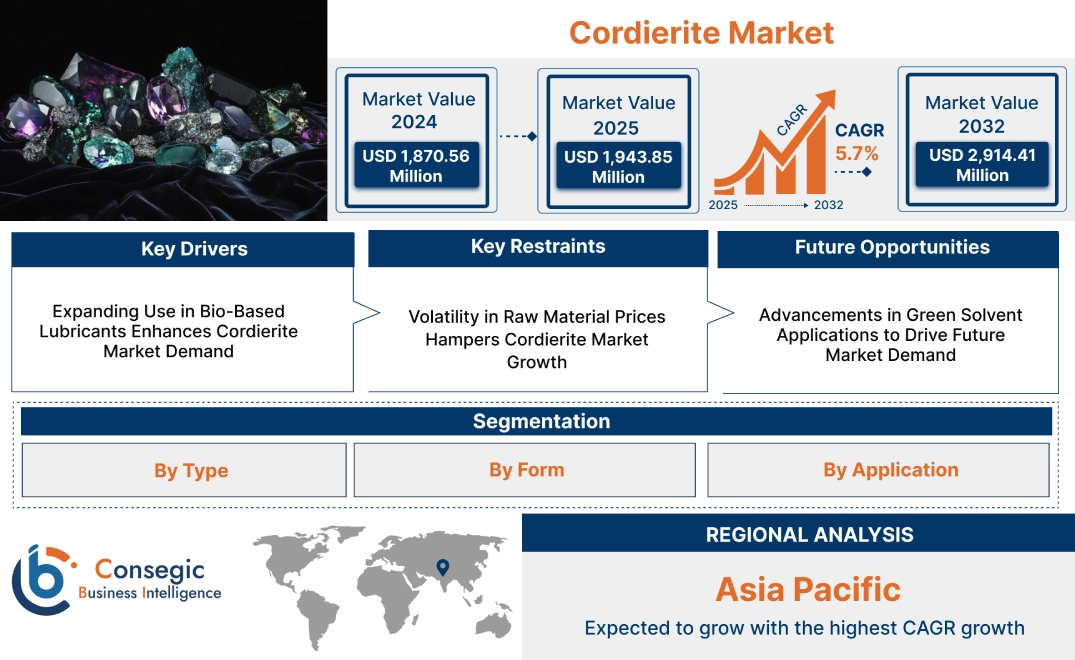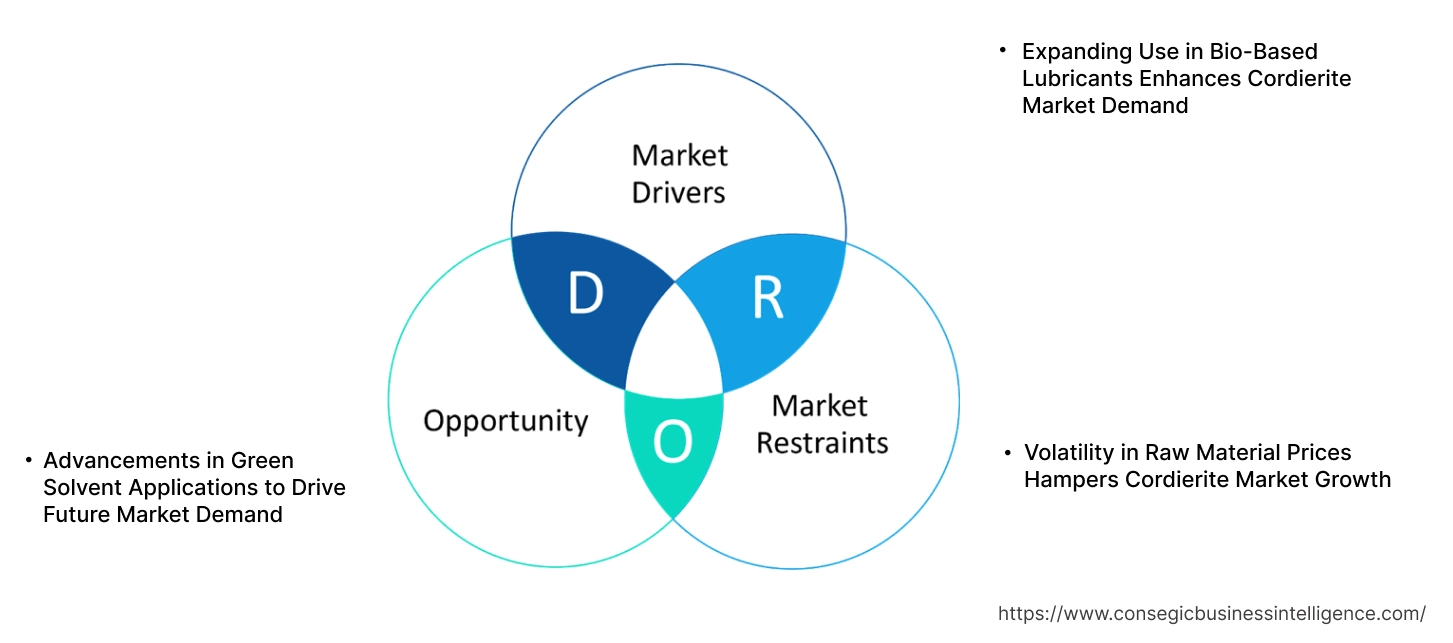Cordierite Market Size:
Cordierite Market size is estimated to reach over USD 2,914.41 Million by 2032 from a value of USD 1,870.56 Million in 2024 and is projected to grow by USD 1,943.85 Million in 2025, growing at a CAGR of 5.7% from 2025 to 2032.
Cordierite Market Scope & Overview:
Cordierite is a magnesium aluminum silicate mineral known for its low thermal expansion, high thermal stability, and excellent resistance to thermal shock. It is lightweight, durable, and exhibits superior mechanical strength. These properties make it suitable for applications requiring high-temperature resistance and structural integrity.
It is widely used in automotive components, industrial ceramics, and refractory applications. It enhances thermal efficiency in catalytic converters, kiln furniture, and heat exchangers. Its low thermal conductivity helps reduce energy consumption in high-temperature environments.
The material finds applications in the automotive, aerospace, electronics, and energy industries. It plays a critical role in emission control systems, electronic substrates, and insulation materials. Its use in advanced manufacturing processes contributes to efficiency and durability across various industrial applications.
Cordierite Market Dynamics - (DRO) :
Key Drivers:
Expanding Use in Bio-Based Lubricants Enhances Cordierite Market Demand
Bio-based lubricants are increasingly popular in multiple industries, primarily due to their eco-friendly nature, improved biodegradability, and lower toxicity compared to conventional lubricants. These lubricants, formulated using carboxylic acid-based esters, offer excellent performance features such as enhanced solvency, low volatility, and superior thermal stability. These esters not only improve the lubrication performance but also reduce the overall environmental impact. As a result, bio-based lubricants are being adopted across diverse sectors, including automotive, industrial machinery, and marine applications. The growing emphasis on sustainability and compliance with stringent environmental regulations is driving the cordierite market trend for bio-based alternatives. Consequently, carboxylic acid-based esters play a pivotal role in meeting the increasing trend for environmentally friendly and efficient lubricants, propelling their use and cordierite market growth.
Key Restraints:
Volatility in Raw Material Prices Hampers Cordierite Market Growth
The production of carboxylic acid-based esters depends on key raw materials such as alcohols and carboxylic acids, which are primarily derived from petrochemical sources and natural materials. These raw materials are subject to price fluctuations due to factors such as volatility in crude oil prices, disruptions in the supply chain, and geopolitical tensions. The resulting price instability can significantly affect manufacturing costs, reducing profit margins for producers and impeding overall cordierite market trend. Furthermore, reliance on petrochemical-based feedstocks raises sustainability concerns, as they contribute to environmental degradation and resource depletion. Consequently, the volatility in raw material prices remains a critical constraint that hampers the consistent trend and stability of the carboxylic acid-based esters market.
Future Opportunities :
Advancements in Green Solvent Applications to Drive Future Market Demand
The ongoing shift towards sustainability, coupled with increased regulatory support for eco-friendly alternatives, is driving research into green solvents as replacements for traditional petroleum-based solvents. Carboxylic acid-based esters, with their favorable properties such as low toxicity, high solvency, and biodegradability, are well-suited for applications in a variety of sectors including paints, coatings, adhesives, and personal care products. As the cordierite market trend for greener and safer alternatives to conventional chemicals continues to grow, carboxylic acid-based esters are positioned to benefit significantly.
Furthermore, the evolution of green chemistry and the development of innovative solutions in solvent technology are expected to expand the application scope of these esters. As a result, the carboxylic acid-based esters market stands to capitalize on the growing adoption of green solvents, creating significant cordierite market opportunities for expansion and innovation across industries.
Cordierite Market Segmental Analysis :
By Type:
Based on type, the market is segmented into sintered cordierite and porous cordierite.
The sintered cordierite sector accounted for the largest revenue in cordierite market share by 62.50% in 2024.
- Sintered cordierite is a ceramic material widely used in industries such as automotive and electronics due to its excellent thermal stability, resistance to thermal shock, and low expansion properties.
- It plays a crucial role in applications where high temperatures are involved, such as in automotive catalytic converters, which require high heat resistance and durability.
- Additionally, sintered cordierite is used in the production of high-performance ceramics and insulating materials.
- The growing trend for emission reduction technologies in the automotive sector, combined with increasing industrial activities, continues to drive the trend for sintered cordierite products.
- This sector benefits from its ability to withstand severe conditions, leading to a long-lasting and efficient material in high-heat applications.
- Therefore, according to cordierite market analysis, the sintered cordierite sector leads the market due to its durability and thermal stability, which make it indispensable in automotive and industrial applications.
The porous cordierite sector is anticipated to register the fastest CAGR during the forecast period.
- Porous cordierite, known for its light weight and high porosity, is widely used in catalytic converters and filtration systems.
- Its structure makes it ideal for filtering exhaust gases in automotive applications, as it allows for effective catalyst retention while minimizing the overall weight of the component.
- The adoption for energy-efficient and environmentally friendly products is driving the adoption of porous cordierite, particularly in the automotive sector, where emissions standards are becoming increasingly stringent.
- The growing focus on reducing carbon emissions is expected to enhance the trend for porous cordierite products.
- Thus, according to cordierite market analysis, the porous cordierite sector's fast-growing adoption in automotive and filtration systems underscores its significant potential as emissions regulations tighten globally.
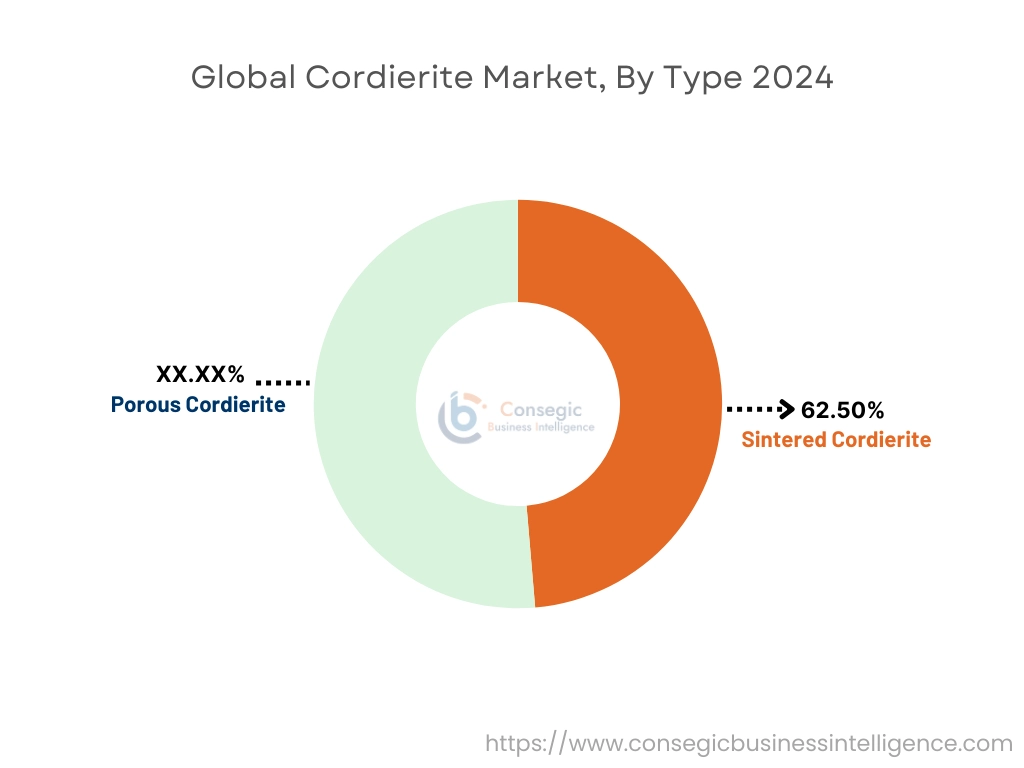
By Form:
Based on form, the market is segmented into cordierite ceramics, cordierite honeycomb structures, cordierite refractories, raw cordierite, and others.
The cordierite honeycomb structures sector accounted for the largest revenue in cordierite market share in 2024.
- Cordierite honeycomb structures are highly valued in automotive exhaust systems, particularly in catalytic converters, due to their ability to provide a high surface area for the reaction without significantly increasing weight.
- These structures also excel in thermal stability and resistance to high temperatures and chemical degradation, making them a preferred choice for applications in automotive and aerospace industries.
- Additionally, the need for lightweight, high-efficiency materials in the automotive sector, along with the increased focus on reducing vehicle emissions, is driving the growth of this sector.
- Therefore, according to the market analysis, cordierite honeycomb structures dominate the market due to their crucial role in emissions control and their efficiency in high-temperature applications.
The cordierite ceramics sector is anticipated to register the fastest CAGR during the forecast period.
- Cordierite ceramics are extensively used in applications that require high-temperature resistance, such as in kiln linings, heating elements, and industrial furnaces.
- With ongoing advancements in material science and manufacturing technologies, cordierite ceramics are increasingly being incorporated into high-performance applications that require durability and low expansion rates.
- The growing trend towards automation and energy-efficient industrial processes is expected to drive further adoption in industrial settings.
- Thus, according to the market analysis, expanding use of cordierite ceramics in energy-efficient and high-temperature applications supports its rapid growth within the market.
By Application:
Based on application, the market is segmented into automotive parts, deodorization and deoxidation smoke extraction, ceramic kilns, infrared radiators, electrical insulators, welding strip rings, and others.
The automotive parts sector accounted for the largest revenue share in 2024.
- Automotive parts, particularly catalytic converters, are the largest application segment for cordierite.
- The material’s excellent thermal shock resistance, combined with its low thermal expansion and high porosity, makes it an ideal choice for emission control systems in vehicles.
- As emissions regulations become stricter worldwide, the need for automotive parts utilizing cordierite, such as in catalytic converters, is expected to continue to increase.
- Furthermore, the growing adoption of electric vehicles (EVs) and the emphasis on green technologies in the automotive industry contribute to the expansion of the automotive parts application.
- Therefore, according to the market analysis, the automotive parts segment leads due to the crucial role of cordierite in reducing vehicle emissions, with ongoing regulatory pressure fueling continued ask.
The deodorization and deoxidation smoke extraction sector is anticipated to register the fastest CAGR during the forecast period.
- This sector benefits from cordierite's ability to filter and purify gases, including in industrial settings where harmful emissions need to be neutralized.
- The material’s resistance to high temperatures and its ability to withstand harsh chemical environments make it an ideal choice for air purification systems.
- As environmental regulations become more stringent, industries are increasingly focusing on effective deodorization and deoxidation solutions, driving the need for cordierite products in this application.
- Thus, according to the market analysis, the requirement for cleaner industrial processes and stringent regulations will likely spur rapid growth in the deodorization and deoxidation smoke extraction sector, further driving the market for cordierite products.
Regional Analysis:
The regional segment includes North America, Europe, Asia Pacific, Middle East and Africa, and Latin America.
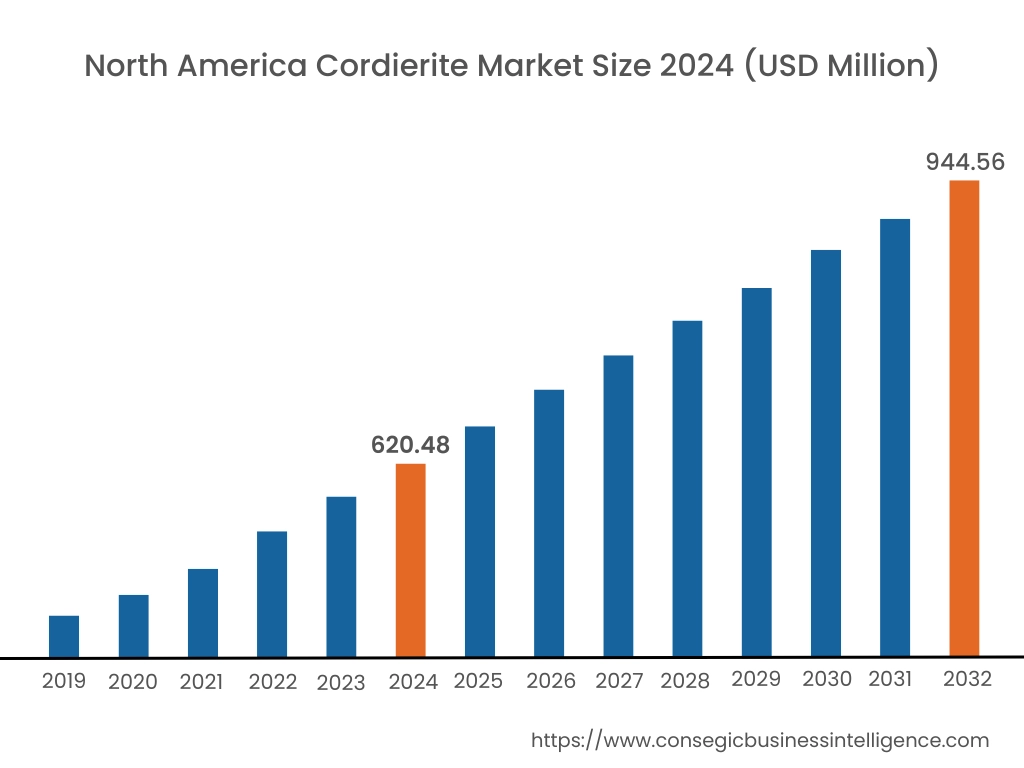
In 2024, North America was valued at USD 620.48 Million and is expected to reach USD 944.56 Million in 2032. In North America, the U.S. accounted for the highest share of 71.11%during the base year of 2024.
The cordierite market in North America remains stable, with the United States leading in demand due to its thriving automotive and industrial sectors. The need for high-performance materials in catalytic converters and kiln furniture boosts market performance. Additionally, the increasing need for energy-efficient and environmentally friendly products is influencing the market in the region. The U.S. and Canada’s well-established manufacturing infrastructure further supports the growth of cordierite-based products, particularly in ceramics and industrial applications.
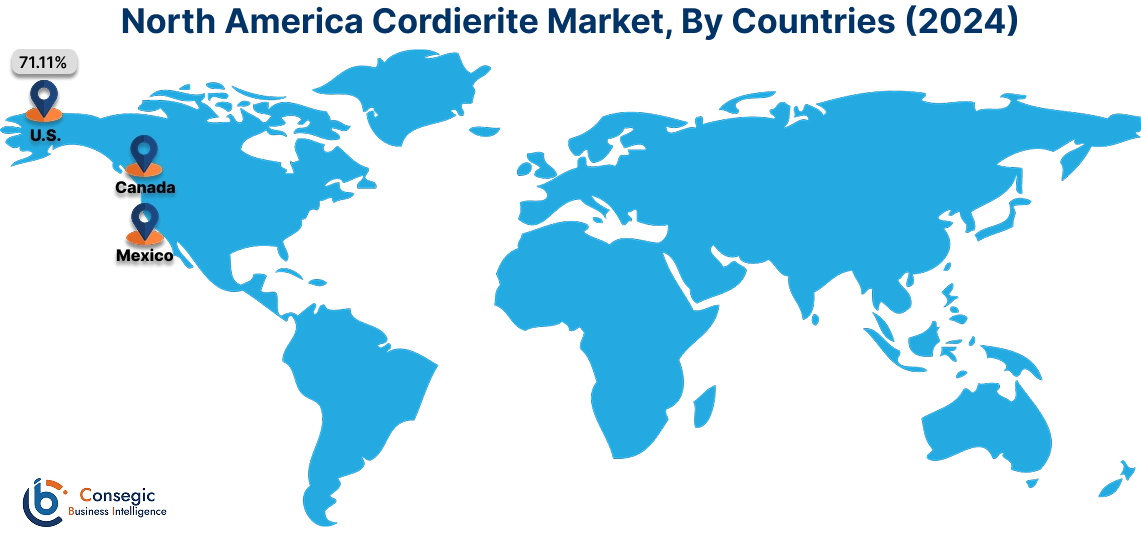
In Asia Pacific, the market is experiencing the fastest growth with a CAGR of 6.1% over the forecast period.
Asia-Pacific holds the largest share of the cordierite market, primarily driven by rapid industrialization in countries like China, India, and Japan. The region’s booming automotive industry, particularly the production of catalytic converters, contributes significantly to cordierite need. The growing construction and ceramics industries in emerging economies also provide opportunities for cordierite market expansion. Furthermore, advancements in manufacturing technologies and the rising focus on sustainable materials in Asia-Pacific enhance the adoption of cordierite for various applications.
In Europe, the market is well-established, with countries like Germany, the United Kingdom, and France leading in demand. The region’s strict environmental regulations, particularly in the automotive sector, push the need for advanced catalytic converter materials. Cordierite’s thermal shock resistance properties also make it valuable in industries like ceramics and heating systems. Additionally, the increasing focus on renewable energy and energy-efficient solutions in the region creates cordierite market opportunities for the expansion of cordierite usage in various industrial applications.
The cordierite market in the Middle East and Africa (MEA) is expanding, driven by increasing industrial activities in regions like the UAE and South Africa. The need for cordierite in automotive applications, particularly for catalytic converters, is rising due to stricter emission standards. Furthermore, the growth of the construction and ceramics sectors in countries like Saudi Arabia and South Africa supports the market. The region’s ongoing focus on infrastructure development and industrialization continues to enhance demand for cordierite-based products.
Latin America shows steady demand for cordierite, particularly in countries like Brazil and Mexico. The automotive industry in the region is a major consumer of cordierite, primarily for catalytic converters. The increasing construction activities, especially in Brazil, contribute to the ask for cordierite in ceramic applications. Economic fluctuations and regional challenges may impact the market, but the continued focus on energy-efficient and environmentally-friendly products sustains demand for cordierite in key industries.
Top Key Players & Market Share Insights:
The global cordierite market is highly competitive with major players providing products and services to the national and international markets. Key players are adopting several strategies in research and development (R&D), product innovation, and end-user launches to hold a strong position in the global cordierite market. Key players in the Cordierite industry include-
- DENSO Corporation (Japan)
- Kyocera Corporation (Japan)
- CoorsTek Inc. (United States)
- Unifrax LLC (United States)
- CeramTec GmbH (Germany)
- Corning Inc. (United States)
- TOTO Ltd. (Japan)
- NGK Insulators Ltd. (Japan)
- Vesuvius Plc (United Kingdom)
- Elementis Plc (United Kingdom)
Recent Industry Developments :
Partnerships & Collaborations:
- In May 2023, Denso Corporation, a leading supplier in the mobility industry, partnered with United Semiconductor Japan Co., Ltd., a subsidiary of United Microelectronics Corporation. This collaboration aims to enhance the development and production of advanced semiconductor components, leveraging cordierite's exceptional thermal properties.
Cordierite Market Report Insights:
| Report Attributes | Report Details |
| Study Timeline | 2019-2032 |
| Market Size in 2032 | USD 2,914.41 Million |
| CAGR (2025-2032) | 5.7% |
| By Type |
|
| By Form |
|
| By Application |
|
| By Region |
|
| Key Players |
|
| North America | U.S. Canada Mexico |
| Europe | U.K. Germany France Spain Italy Russia Benelux Rest of Europe |
| APAC | China South Korea Japan India Australia ASEAN Rest of Asia-Pacific |
| Middle East and Africa | GCC Turkey South Africa Rest of MEA |
| LATAM | Brazil Argentina Chile Rest of LATAM |
| Report Coverage |
|
Key Questions Answered in the Report
How big is the Cordierite Market? +
In 2024, the Cordierite Market was USD 1,870.56 million.
What will be the potential market valuation for the Cordierite Market by 2032? +
In 2032, the market size of Cordierite Market is expected to reach USD 2,914.41 million.
What are the segments covered in the Cordierite Market report? +
The type, form, and application are the segments covered in this report.
Who are the major players in the Cordierite Market? +
DENSO Corporation (Japan), Kyocera Corporation (Japan), Corning Inc. (United States), TOTO Ltd. (Japan), NGK Insulators Ltd. (Japan), Vesuvius Plc (United Kingdom), Elementis Plc (United Kingdom), CoorsTek Inc. (United States), Unifrax LLC (United States), CeramTec GmbH (Germany) are the major players in the Cordierite market.
